Nature abounds in all parts of the world with its wonderful and mystic hues which at times bewilders us and also enthrals us with its lovely and myriad forms of flora and fauna.
We all know about Ginger as a spice.But biologically it is called a Rhizome.Similar Rhizomes are Turmeric used widely in India and Galangal which is used in Asian food – Chinese,Malayan and Thai.But apart from this which very less people know is this root or Rhizome called Curcuma Amada which is one of Nature’s lovely gifts to mankind.The root looks like Ginger and the aroma and taste is of a raw Mango which lends the name – Mango Ginger to this root!
Mango Ginger
Mango Ginger(left) and the common Ginger root(right)!
Mango Ginger is used to make Pickles in South India as the plant is extensively found from Kerala to Andhra Pradesh.There are many brands selling Mango Ginger Pickles and due to its exclusive availability only down South and only in the time between the months July – October,it comes under the Exotic Foods category.
“Ayurveda and Unani medicinal systems have given much importance to mango ginger as an appetizer, alexteric, antipyretic, aphrodisiac, diuretic, emollient, expectorant and laxative and to cure biliousness, itching, skin diseases, bronchitis, asthma, hiccough and inflammation due to injuries. The biological activities of mango ginger include antioxidant activity, antibacterial activity, antifungal activity, anti-inflammatory activity, platelet aggregation inhibitory activity, cytotoxicity, antiallergic activity, hypotriglyceridemic activity, brine-shrimp lethal activity, enterokinase inhibitory activity, CNS depressant and analgesic activity.”
Information Courtesy – Google
Its very difficult to find Mango Ginger apart from the South Indian states but it is available as a seasonal produce in metros like Mumbai.However if you do find it then do not hesitate to buy it as it makes one of the yummiest pickles ever known.Make the pickle as fast as you can as the root hardens in 3-4 days and does not taste as fresh and piquant.
NOTES –
1.Originally Sesame Oil(Til ka Tel) is used for the pickle.However if you do not like the taste then use Rice Bran Oil as it imparts a good flavour and neutral taste to the recipe!
2.I have used Tamarind Paste easily available in the market these days.If you do not get it then soak 200 gms Tamarind in 1/2 liter of warm water for 30 minutes.Strain the water and boil till a little thick.Cool to room temperature and use this for Tamarind paste.
3.*Smoking Point means heating the Oil such that fumes come out from it.As soon as you notice fumes immediately take off heat and keep it uncovered till it comes to room temperature.NEVER handle hot Oil as it might cause serious burns.
4.I have used Kashmiri Chili Powder which gives a beautiful Orangish Colour to the Pickle and is not too fiery.You can also use Deghi Mirch or Guntur Chili Powder (exclusively available in Andhra Pradesh known for its brilliant Orange colour and characteristic taste)!
Now after this extensive knowledge and view of this wonderful plant lets go on to the recipe:-
Preparation Time : 1 1/2 – 2 hours
Makes : 750 gms of Pickle
INGREDIENTS
500 gms Mango Ginger root
1/2 cup Salt
1/2 cup powdered Jaggery(Gud)
2 cups Oil (Sesame/Rice Bran)
1/4 cup Water
Juice of 2 Lemons
2 tbsp black Mustard Seeds (Rai)
4-5 Round Red Chilies(Button Chilies)/plain dried red Chilies
1 tbsp Asafoetida(Heeng)
2 tsp Turmeric Powder(Haldi)
For the Spice Powder:
2 tbsp Fenugreek Seeds(methi)
3 tbsp black Mustard seeds (Rai)
15 Curry Leaves
7-8 dried red Kashmiri Chilies/3 tbsp Kashmiri Chili Powder/Deghi Mirch Powder
METHOD
With a vegetable peeler or paring knife scrape the thin and papery skin from the Mango Ginger roots taking care that no part of the root is wasted.Keep aside.
The peeled Mango Ginger
Prepare the Spice Powder:
Dry roast all ingredients individually in a pan and leave to cool till room temperature.This includes the Curry Leaves as well.They turn brittle and crisp when dry roasted and can be easily powdered.
WARNING – Do not roast the red chilies on high heat as it leads to fumes and will cause choking and watery eyes.
Or use any of the the chili powders.Spoon the powder into the grinder as well so that it is ground and merged with the other spices.
Powder all ingredients in a coffee grinder or jar and keep aside.
The Powder..
Preparing the Mango Ginger Paste:
In a Chutney grinder add the lime juice and Tamarind paste.Add the peeled roots and water and grind till it becomes like a chutney.Keep aside.
The Mango Ginger Paste..
Making the Pickle:
Heat 1 cup of Oil in a non stick pan to smoking point* and add the mustard seeds and dried red chilies.When the mustard seeds splutter add Asafoetida and Turmeric Powder.Fry on low heat for 2-3 minutes and add the Mango Ginger Paste.Raise heat to medium and fry the paste for 5-6 minutes till the raw smell disappears.
Now add the spice powder and mix well.Here you would see the beautiful red colour come into the pickle which is so characteristic of South Indian Pickles!Add the salt and Jaggery powder and cook for a further 10 minutes till Oil floats on top and the pickle is well mixed and cooked.
Cover the pan with a very clean kitchen towel and leave to come to room temperature.
Meanwhile heat the remaining 1 cup Oil to smoking point*.Remove from heat and let it come to room temperature.
After the pickle and Oil have come to room temperature,ladle the Pickle into clean jars.Fill 3/4 of the jars and pour the prepared Oil to cover the pickle.
Keep the pickle as it is for a day.Then keep it in the Sun for 3-4 days and then keep refrigerated!Will keep for infinite time if used with proper care.
Some shots of the pickle…










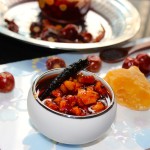
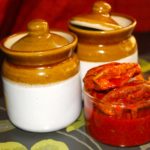
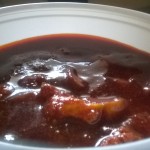
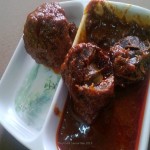
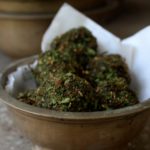
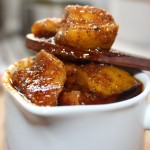

















Looks delicious very nice recipe.